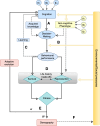The evolutionary puzzle of cognition: challenges and insights from individual-based studies
- PMID: 40566911
- PMCID: PMC12198901
- DOI: 10.1098/rstb.2024.0123
The evolutionary puzzle of cognition: challenges and insights from individual-based studies
Abstract
Cognition is widely believed to confer adaptive benefits, yet empirically demonstrating these benefits and understanding their evolutionary origin remains a significant challenge. Individual-based studies in the wild are essential for demonstrating that a cognitive trait is an adaptation. However, such approaches have so far yielded only partial evidence for the adaptive significance of cognition. Building on previous research, we highlight key challenges of individual-based studies that remain underappreciated and warrant further attention. These include the need for precise characterization of functionally relevant cognitive traits, a deeper understanding of heritable variation, more robust assessments of key fitness components across large cohorts and extended timescales, and clearer identification of the fitness benefits and selective pressures involved. We discuss how the lack of such comprehensive information limits our ability to fully evaluate how cognitive traits affect fitness, and to explore their demographic and evolutionary consequences. To bridge the gap between micro- and macroevolutionary processes, we also emphasize the need to better integrate individual-based research with broader population and species comparative analyses. By refining and expanding the approach, individual-based studies can deepen our insight into the evolutionary forces that have given rise to the remarkable diversity of minds across the animal kingdom.This article is part of the Theo Murphy meeting issue 'Selection shapes diverse animal minds'.
Keywords: Bogert effect; fitness; natural selection; phylogenetic-based analyses; problem-solving; spatial memory.
Conflict of interest statement
We declare we have no competing interests.
Figures



Similar articles
-
Linking individual fitness to the evolution of cognition.Philos Trans R Soc Lond B Biol Sci. 2025 Jun 26;380(1929):20240122. doi: 10.1098/rstb.2024.0122. Epub 2025 Jun 26. Philos Trans R Soc Lond B Biol Sci. 2025. PMID: 40566913 Review.
-
How does cognition determine an individual's fitness? A systematic review of the links between cognition, behaviour and fitness in non-human animals.Philos Trans R Soc Lond B Biol Sci. 2025 Jun 26;380(1929):20240118. doi: 10.1098/rstb.2024.0118. Epub 2025 Jun 26. Philos Trans R Soc Lond B Biol Sci. 2025. PMID: 40566909 Free PMC article.
-
Living on the edge: the evolution of spatial cognition in food-caching chickadees.Philos Trans R Soc Lond B Biol Sci. 2025 Jun 26;380(1929):20240120. doi: 10.1098/rstb.2024.0120. Epub 2025 Jun 26. Philos Trans R Soc Lond B Biol Sci. 2025. PMID: 40566916 Review.
-
Demonstrating the reproductive consequences of cognition: learning from experience.Philos Trans R Soc Lond B Biol Sci. 2025 Jun 26;380(1929):20240115. doi: 10.1098/rstb.2024.0115. Epub 2025 Jun 26. Philos Trans R Soc Lond B Biol Sci. 2025. PMID: 40566918 Free PMC article.
-
Signs and symptoms to determine if a patient presenting in primary care or hospital outpatient settings has COVID-19.Cochrane Database Syst Rev. 2022 May 20;5(5):CD013665. doi: 10.1002/14651858.CD013665.pub3. Cochrane Database Syst Rev. 2022. PMID: 35593186 Free PMC article.
Cited by
-
Linking individual fitness to the evolution of cognition.Philos Trans R Soc Lond B Biol Sci. 2025 Jun 26;380(1929):20240122. doi: 10.1098/rstb.2024.0122. Epub 2025 Jun 26. Philos Trans R Soc Lond B Biol Sci. 2025. PMID: 40566913 Review.
-
Selection shapes diverse animal minds.Philos Trans R Soc Lond B Biol Sci. 2025 Jun 26;380(1929):20240108. doi: 10.1098/rstb.2024.0108. Epub 2025 Jun 26. Philos Trans R Soc Lond B Biol Sci. 2025. PMID: 40566907 Free PMC article.
References
-
- Shettleworth SJ. 2010. Cognition, evolution, and behavior. Oxford, UK: Oxford University Press.
-
- Bucciarelli JR, Pimm SL, Huang RM, Chase MJ, Leggett K, Bastos AD, van Aarde RJ. 2024. Local elephant movements, turning angles, and water access across a rainfall gradient in southern Africa. Biol. Conserv. 296, 110669. ( 10.1016/j.biocon.2024.110669) - DOI
-
- Allman JM. 1999. Evolving brains. New York, NY: Scientific American Library.
Publication types
MeSH terms
LinkOut - more resources
Full Text Sources
Miscellaneous

